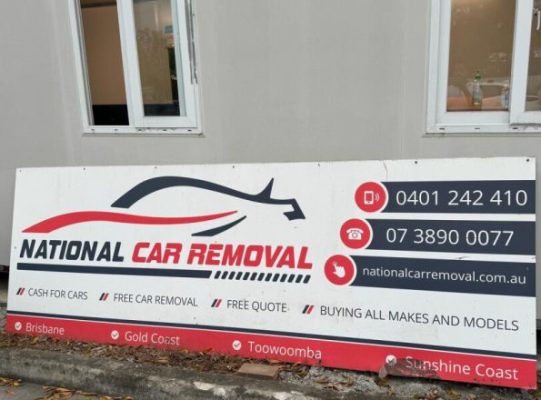
If you have ever sold or given away an old car through a removal service, you might have wondered what happens to it afterwards. Does it just get crushed into scrap metal, or is there more to the process? The truth is that car removal and recycling is an organised system that ensures cars are disposed of in a safe, environmentally friendly, and useful way.
In this guide, we will walk through the journey of a car after removal, from collection to recycling. You will learn how different parts of a vehicle are treated, why recycling is important, and how this process benefits both the community and the environment.
Step One: Collection and Towing
The process begins with the removal company collecting your vehicle. In most cases, towing is free of charge, which makes it convenient for the owner. The car is loaded onto a tow truck and taken to a recycling or wrecking facility.
This step is not just about moving the car, it also ensures the vehicle is handled safely. Abandoned or broken cars can leak fluids, so professionals make sure they are transported in a way that prevents damage to the environment.
Step Two: De-pollution and Fluid Removal
Once the car reaches the facility, the next step is to remove all hazardous fluids. Vehicles contain oils, coolants, brake fluids, and fuel that can harm the environment if they are left to leak. These are drained carefully and stored for proper disposal or recycling.
This step is crucial for protecting soil and water supplies. By removing these fluids early, recyclers stop harmful chemicals from spreading into the community. It also prepares the car for safe dismantling later in the process.
Step Three: Removing Usable Parts
Many parts of a car can still be used, even if the vehicle no longer runs. Engines, transmissions, alternators, and starter motors are often salvaged. Other items like mirrors, headlights, doors, and tyres are also collected. These parts are cleaned, tested, and resold as second-hand spares.
This step is important because it allows car owners who cannot afford new parts to buy reliable used ones at a lower price. It also reduces the demand for new manufacturing, which saves energy and resources.
Step Four: Dismantling and Recycling Materials
After useful parts are taken out, the car’s frame and remaining components are dismantled. Materials such as steel, aluminium, and copper are sorted and prepared for recycling. Metal is especially valuable because it can be melted down and reused without losing its strength.
Other materials like glass, plastic, and rubber are also processed. Tyres, for example, can be recycled into road materials or sports surfaces. This step ensures that almost every part of the car is put to good use instead of ending up in landfill.
Step Five: Crushing and Shredding
Once all reusable and recyclable items are removed, the remaining car body is crushed or shredded. Large machines reduce the vehicle into smaller pieces that are easier to transport and process.
The shredded metal is then sent to smelters where it is melted down and turned into raw material. This material can be used to make new cars, construction materials, appliances, and more. By recycling metals, energy use is reduced compared to mining and producing new materials.
Why Car Recycling Matters
Recycling old cars is not just about clearing space, it has a direct impact on the environment and local communities. By recycling:
-
Harmful fluids are kept out of soil and water.
-
Metal waste is reduced, lowering the demand for mining.
-
Landfills are kept free of bulky, non-biodegradable materials.
-
Communities stay cleaner and safer without abandoned vehicles.
Car recycling ensures that valuable resources are recovered and reused, making it a smart and responsible choice.
About National Car Removal Brisbane
A trusted name in the industry, National Car Removal Brisbane is well known for its fair service and commitment to quality. The company makes the car removal process easy by offering free towing and on-the-spot payments, giving customers peace of mind.
In addition to car removals, the company also provides affordable tech products, giving people access to reliable items at reasonable prices. This adds value to the community and shows their focus on keeping quality within reach for everyone.
Customers also recognise National Car Removal Brisbane for its dependable customer service. The team is approachable, responsive, and ensures the process runs smoothly from start to finish. This level of care has helped the company build trust across the Brisbane region.
By combining fair valuations, accessible products, and a focus on recycling, National Car Removal Brisbane stands out as a business that not only serves its customers but also contributes to cleaner and more sustainable communities.
Do all parts of the car get recycled?
Not every single piece is recycled, but the majority is. Metals, plastics, glass, and rubber are processed, and fluids are disposed of safely.
Can I still sell my car if it is not running?
Yes, car removal companies accept vehicles in any condition, including non-runners.
What happens to the tyres?
Tyres are often recycled into materials for roads, playgrounds, or sports fields.
How quickly is the process done?
Collection is usually same day or next day, and the recycling process begins shortly after.
Why should I choose car removal instead of landfill disposal?
Car removal ensures valuable parts and materials are reused, reducing waste and protecting the environment.
When you hand over your old car to a removal service, it goes through a careful process of de-pollution, dismantling, recycling, and repurposing. Almost every part of the vehicle finds a new use, whether as spare parts, recycled metals, or materials for other industries.
Car removal and recycling not only help individual car owners but also support the wider community by reducing waste, preventing pollution, and saving resources. By choosing a trusted service, you can be confident that your old car is being handled responsibly and contributing to a cleaner future.





